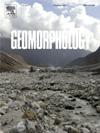降水量和构造隆升的空间变化导致的流域分水岭东移,促成了西藏东南部横断山脉平行河流的形成
IF 3.1
2区 地球科学
Q2 GEOGRAPHY, PHYSICAL
引用次数: 0
摘要
在横断山脉(西藏东南部),南流的恩迈赫卡河(伊洛瓦底江上游)、怒江(萨尔温江上游)、澜沧江(湄公河上游)和金沙江(长江上游)相互平行,相互靠近,从而形成了一种独特的地貌构造(即平行河流)。有人认为,这种构造是构造缩短将河流 "挤压 "在一起的结果。尽管该地区的构造和地表过程已被广泛研究,但导致这种构造的过程仍存在争议。在此,我们研究了排水沟迁移在平行河流形成过程中的潜在作用。根据对平行河流之间分水岭稳定性的地貌分析,我们发现西部的两条分水岭(怒江-怒江、怒江-澜沧江)很可能在向东迁移,而东部的分水岭(澜沧江-金沙江)则基本稳定。这一模式表明,平行河流的形成与正在迁移的分水岭与固定分水岭的对接有关。全球定位系统和降水数据以及先前的研究表明,西部两个分水岭的迁移是由降水和岩石隆起的空间变化驱动的。同时,东部分水岭的稳定性受到气候和构造因素以及历史上河流截流事件的综合影响。这意味着平行河流的形成并不一定是东西构造缩短的结果,而是受到降水和构造隆升空间变化的影响。本文章由计算机程序翻译,如有差异,请以英文原文为准。
Eastward drainage-divide migrations driven by the spatial variations in precipitation and tectonic uplift contribute to the formation of the Parallel Rivers in the Hengduan Mountains, Southeastern Tibet
In the Hengduan Mountains (Southeastern Tibet), the south-draining Nmai Hka (Upper Irrawaddy), Nu (Upper Salween), Lancang (Upper Mekong), and Jinsha (Upper Yangtze) Rivers flow parallel and in proximity to each other, thus forming rather a unique geomorphic configuration (i.e., the Parallel Rivers). It has been suggested that this configuration is an outcome of tectonic shortening that “squeezed” the rivers together. Although the tectonic and surface processes in this region have been extensively studied, the processes that led to this configuration remain controversial. Here, we investigate the potential role of drainage-divide migration in forming the Parallel Rivers. We demonstrate, based on geomorphologic analysis of divide stability between the parallel rivers, that while the two western divides (Nmai-Nu, Nu-Lancang) are likely migrating eastward, the eastern divide (Lancang-Jinsha) is roughly stable. This pattern suggests that the formation of the Parallel Rivers is associated with an abutment of the migrating divides against the fixed one. GPS and precipitation data combined with prior research suggest that the migrations of the two western divides are driven by the spatial variations in precipitation and rock uplift. Concurrently the stability of the eastern divide is influenced by a combination of climatic and tectonic factors, as well as a historical river capture event. This implies that the formation of the Parallel Rivers has not necessarily been an outcome of east-west tectonic shortening but has been influenced by the spatial variations in precipitation and tectonic uplift.
求助全文
通过发布文献求助,成功后即可免费获取论文全文。
去求助
来源期刊

Geomorphology
地学-地球科学综合
CiteScore
8.00
自引率
10.30%
发文量
309
审稿时长
3.4 months
期刊介绍:
Our journal''s scope includes geomorphic themes of: tectonics and regional structure; glacial processes and landforms; fluvial sequences, Quaternary environmental change and dating; fluvial processes and landforms; mass movement, slopes and periglacial processes; hillslopes and soil erosion; weathering, karst and soils; aeolian processes and landforms, coastal dunes and arid environments; coastal and marine processes, estuaries and lakes; modelling, theoretical and quantitative geomorphology; DEM, GIS and remote sensing methods and applications; hazards, applied and planetary geomorphology; and volcanics.
 求助内容:
求助内容: 应助结果提醒方式:
应助结果提醒方式:


